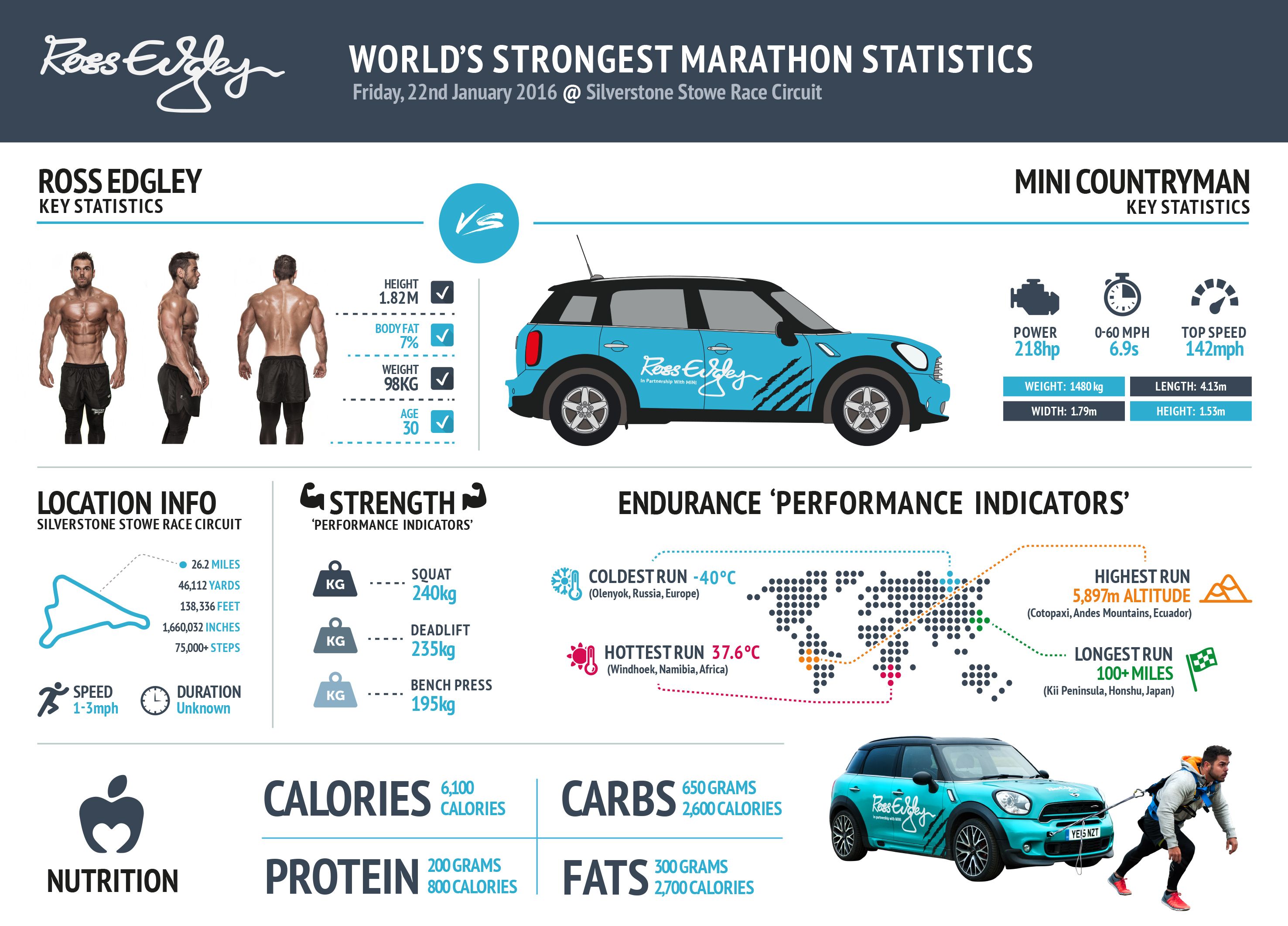This is not a drill. Ross Edgley is genuinely attempting a ‘World’s Strongest Marathon.’
The sports scientist is going to push the human body to the absolute limit by pulling a 1,400kg car along a marathon distance.
For anyone who has done a marathon before, that is 26.2 agonising miles – except with a 1.4 tonne MINI as a backpack.
No human being has ever attempted such an incredible feat of strength and endurance. This is unchartered territory.
Sports scientist, writer and ‘fitness adventurer’ Edgley has trained for eight months and travelled more than 1,600 miles pulling a car – all to raise money for his former coach’s nephew who has a rare form of brain tumour called PNET.
JOE wanted to find out first-hand how he has trained for the ‘World’s Strongest Marathon’.
JOE: What is the theory behind this insane challenge?
Edgley: So often with fitness there’s a sort of move towards minimalism where people are taking rest days all the time.
But with something like the ‘World’s Strongest Marathon’ it’s pure work capacity.
The 1936 Law of Adaption says ‘ if you subject your body to stimuli that it is not accustomed to, it will adapt.’
I have been training for eight months now – sometimes 16 hours a day, just getting mileage in the legs. It is completely unavoidable. It’s not like any other sport or event where you might get by on skill. Nope, the work is unavoidable. You have got to eat 6,000-plus calories a day.
You have got to have fats and carbohydrates, because you won’t be able to do the whole thing solely on carbohydrates. To pull a car weighing 1,400kg at that intensity you will deplete all your muscle glycogen (stored carbohydrates) after about three miles.
So it’s just coconut oil, almond butter, fats, flapjacks and then 16 hours a day training.
This is the theory. We’re going to see if it actually works. You can read thousands of pieces of research, but there comes a time when you have to just get out there and do it.
https://www.instagram.com/p/BAZEG43hn3q/?taken-by=rossedgley
How do you plan and prepare with training?
Nobody has ever done anything like this before. Being able to run a marathon obviously helps and being strong at deadlifts and squats is also a benefit.
Ultimately it’s just the SAID principle – ‘a specific adaptation to imposed demands’ – one of the basic principles of strength and conditioning. Your body will specifically adapt to whatever you subject it to.
It’s a novel movement. You can run, but the bio-mechanics are completely different. You can train and start deadlifting or whatever, but that’s not going to help. The only way with adapting to the physiological demands on your body and the biomechanics is to get a harness, strap it to a car and pull it.
It’s back to this theory of adaption. Learn to do a mile, then do two miles, then eventually if you absolutely hammer your body, 26.2 miles is achievable.
Have you had help with training?
It’s been a melting pot of all these ideas – ‘maybe this will work’ or ‘try this and it could help’. There is no blueprint for this. We have had to develop a whole new training protocol for it.
Coach Matt Taberner, head of strength and conditioning at Everton has been brilliant.
Geoff Capes, two-time World’s Strongest Man, and Andy Bolton, World Powerlifting Champion and the first man to deadlift 1,000lbs, have helped out. Even sprinter Linford Christie too – they’ve all been awesome.
Geoff still holds the world record for the truck pull in World’s Strongest Man. God knows how many tons he pulled, and it was only over 30m, but he’s been awesome.
Firstly he said ‘bulk up’. I was 89kg and now I’m around 100kg. He was right – being so much heavier means you can lean into the movement to overcome that initial inertia. Then, once you’ve got it moving it’s easier. But if you’re too light you’re literally just driving with your legs and it is so hard.
Secondly he said, ‘time your mile, then double it. That’s what you will be working off.’ So if I can pull it well at 2mph, I will probably be doing it at 1mph on the day, in the wind and rain when I’m grinding it out on the 26th mile. He was spot on with that.
https://www.instagram.com/p/BAeOtPehn8y/?taken-by=rossedgley
How have you bulked up?
It’s quite easy to bulk up off 6,000 calories a day. Looking at it from a sports science perspective, the old reps and weight scheme of ’10 reps builds strength’ is fine for your average person.
But to progress and push the body forward you have to look beyond that. Eating 6,000 calories a day and doing the work that you do, your calves and your quads just blow up.
The six and volume of your legs will increase ridiculously. For anyone reading this, if you want your legs to grow, eat 6,000 calories a day and pull a car for 16 hours a day. Believe me, they will grow!
Have you done mostly gym or pulling work?
Most of it has been pulling, it’s pure mileage to train for this. I have been speaking to Andy Bolton because my lower back was fatiguing at certain points. Andy has been brilliant helping me with my core strength and we’ve been working on partial squats.
This is because when you’re pulling a car you’re never fully in that bottom squat position – you never have to generate force through that full range of motion.
So we’ve been putting 270kg on the bar and doing partial-rep squats, because ultimate that’s the range of motion you’re going to use on a challenge like this.
The majority has been getting the miles in and building up. I think too often in fitness we over-complicate things. What’s been so nice about this whole stunt is it’s beautifully simple.
One day you do a mile, the next day you do a bit more and so on, your body adapts to the load. You can’t do 26-mile straight off the bat. It’s a real testament to the law of adaption.
https://www.instagram.com/p/_80oGbhn1i/?taken-by=rossedgley
What did the first mile feel like?
It was horrible. My quads and calves have never felt like that. It was the lactic acid, but also the size. I couldn’t walk properly afterwards because my legs were so pumped.
I’ve been training for eight months and averaging 50 miles a week, so doing the maths I’ve probably done 1,600 miles pulling a 1,400kg car since I’ve started.
It’s pure leg strength to get the car moving and then reps, never overstepping or understepping. There’s a lot biomechanics to it as well because it’s such a novel movement.
If you get better at the movement the 26 miles becomes infinitely easier. I’ve watched my friends have a go in the car park and they go about it all wrong. If you do anything like this over a length of time your body becomes very efficient very quickly.
What’s amazing is how physiologically your body figures out the biomechanics and the easiest way to move.
What strength do you need to take on something like this?
You need to be strong. But it’s a completely different kind of strength. It’s a lot of legs and a lot of lower back, but it’s a weird fusion of strength, stamina and endurance.
The weight is 1,400kg, so you obviously have to be strong to move it. But then you need this stamina and muscular endurance. I’ve had both strongmen and marathon runners tweeting me going ‘mate, how’s this one going to work?’
https://www.instagram.com/p/BAOsH37BnxE/?taken-by=rossedgley
How much stronger and fitter do you think you’ve become training for this challenge?
I think it’s so weird. The best way to describe it is work capacity. I think that is the most underrated component of fitness. It’s your body’s ability to perform and then recover from a workout of a set intensity and duration.
The Bulgarian weightlifting training method was just crazy volume. They would train every single day eight hours a day, 365 days a year. They would never have a day off.
The volume was obscene. The only reason they did that was because they had this insane work capacity – never mind how strong, how quick or how fit they were. It was just their work capacity – their body’s ability to perform and recover from this brutal training regime.
What’s interesting is when I’ve finished this whole thing, I will be left with an insane work capacity.
People who train an hour a day and think they’re tired – but I’ll be like ‘well I’ve just been training 16 hours a day, so I actually feel okay.’
How do you feed yourself for a challenge like this?
Bioenergetics – how all systems derive energy from food – you have to be an expert in this to do any kind of endurance sport.
With this, if you try to do it solely on carbohydrates, after three miles dragging a car you will have no muscle glycogen and your muscles will be like ‘what do you want us to do?’
One thing has been key is training my body to use two different fuel sources. So once my body has been depleted of carbohydrates, my body is actually trained to efficiently run on fats.
But you have to condition your body to be able to do that. You can’t do it on the day. So once I get past five or 10 miles and have burned all my glycogen stories, I know I’ve got MCTs and LCTs (medium- and long-chain triglycerides) in reserve.
https://www.instagram.com/p/BAUAE88hn6R/?taken-by=rossedgley






















































